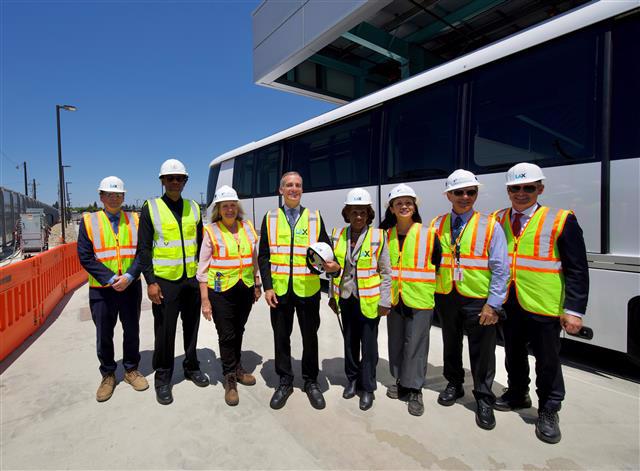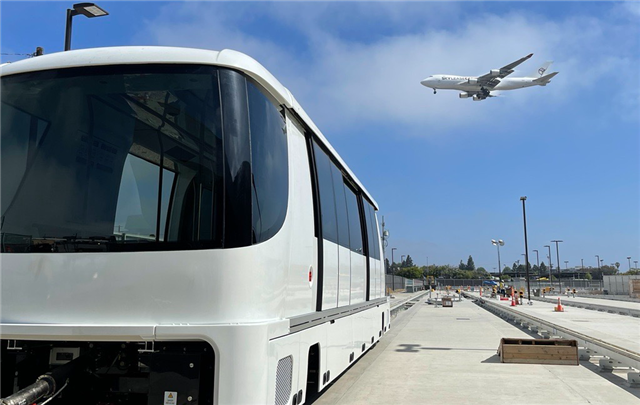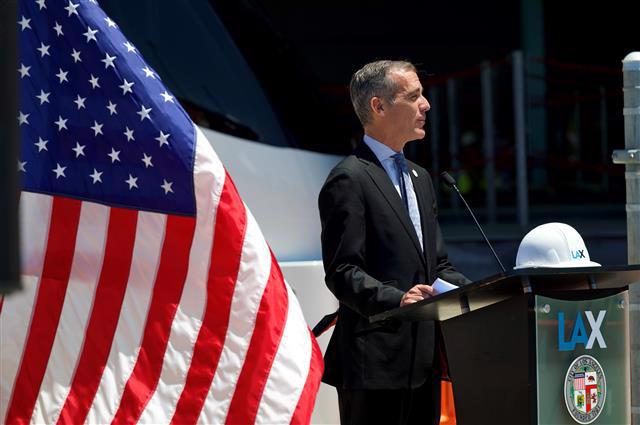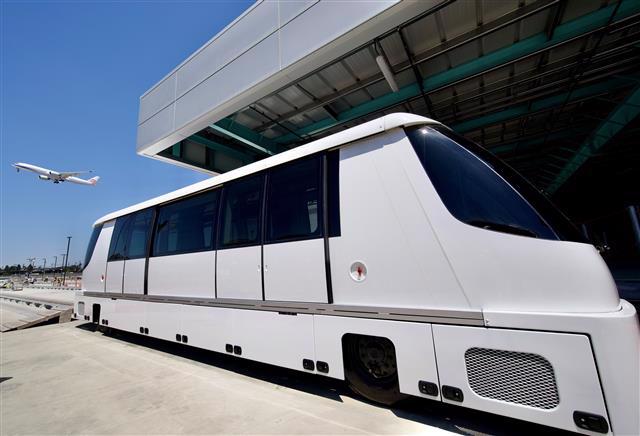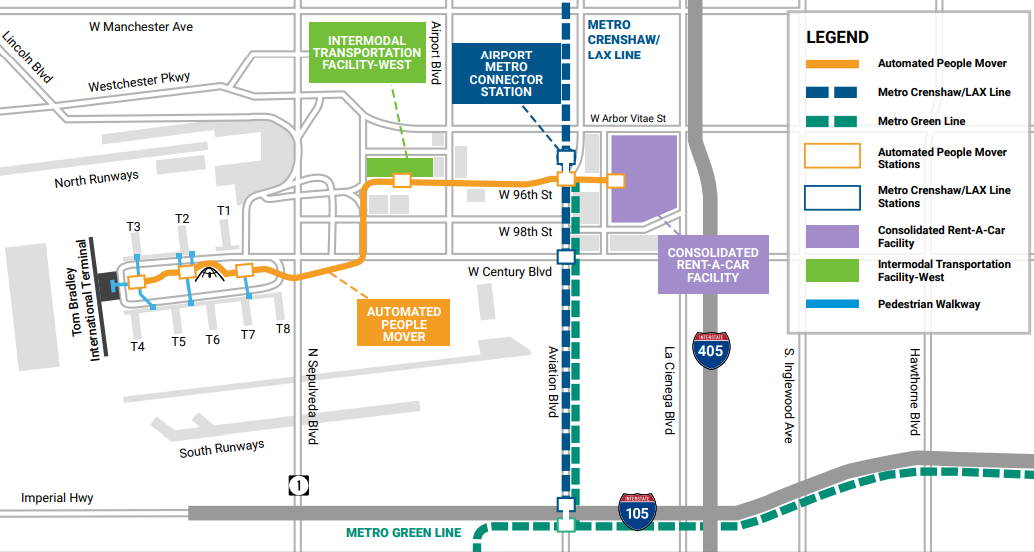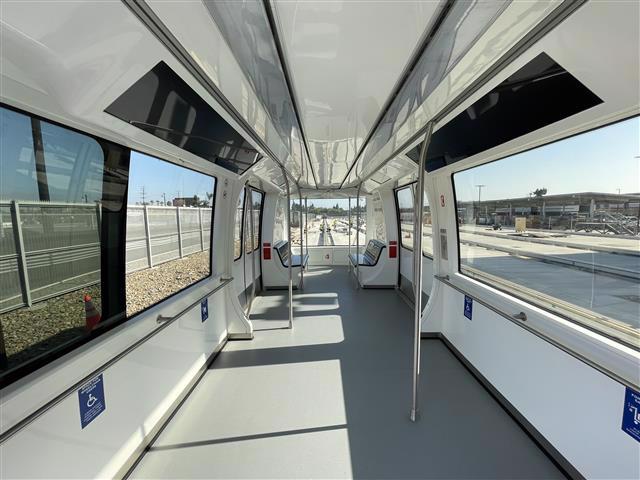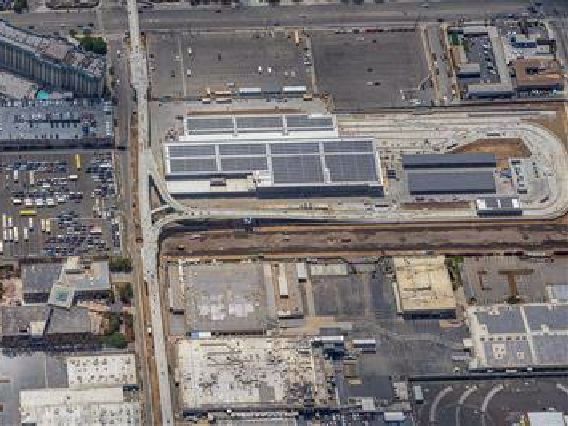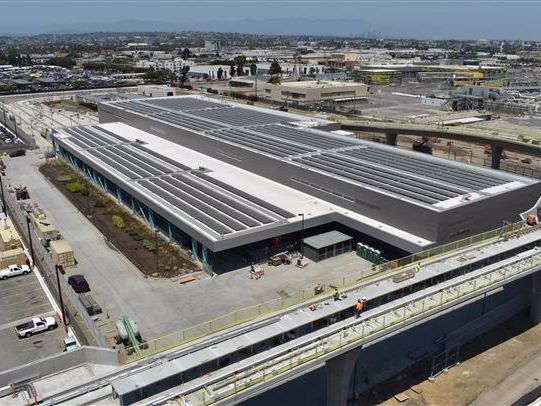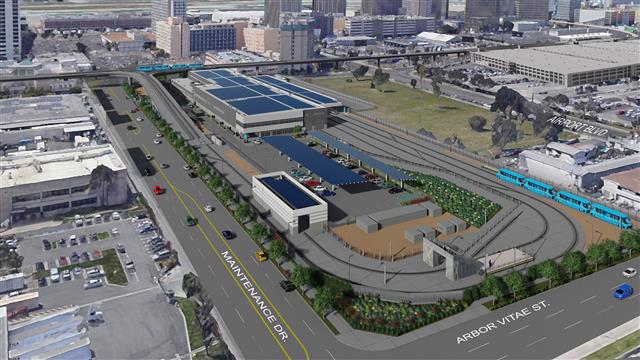|
FOR IMMEDIATE RELEASE
Aug. 2, 2022
CONTACT
LAX Public Relations
(424) 646-5260 |
|
|---|
|
LOS ANGELES INTERNATIONAL AIRPORT UNVEILS FIRST TRAIN CAR FOR THE AUTOMATED PEOPLE MOVER
|
|
|---|
|
Mayor Eric Garcetti, center, unveils the Automated People Mover train car for the first time at LAX.
|
|
|---|
|
|
(Los Angeles) Today, Los Angeles Mayor Eric Garcetti joined city, federal and airport officials to debut a critical component of the future of LAX with the unveiling of the first Automated People Mover (APM) train car. LAX will be the first U.S. airport to feature the
INNOVIA 300 APM vehicles, which showcase the latest technology to help revolutionize how travelers get to and from the fifth-busiest airport in the world.
The APM system will reduce vehicle congestion and traffic in and around LAX when it opens, while providing the long-awaited connection to regional transportation, including Metro light rail.
“The Automated People Mover will be so much more than another way to get to LAX – it’s the piece of the puzzle that will curb the congestion that has been plaguing our airport for decades,” said Mayor Eric Garcetti. “As we welcome the first car that will whisk travelers to renovated terminals, parking structures, Metro rail, and a new rental car facility, it’s clear that a completely reimagined LAX is on the horizon.”
The debut of the train car took place today at what will serve as the operational hub for the APM system – the Maintenance and Storage Facility – and was emceed by Mayor Garcetti. Also joining in the celebration were Rep. Maxine Waters, whose 43rd Congressional District includes LAX, Board of Airport Commissioners (BOAC) President Beatrice Hsu, LAWA Chief Executive Officer Justin Erbacci and Roya Noorbakhsh, the Chief Technical Officer of LAX Integrated Express Solutions (LINXS), developer of the APM system.
Click here to view a new video showing a glimpse of LAX's future when the APM system opens.
"I am excited and proud to see the first train cars delivered for LAX’s Automated People Mover," said Rep. Maxine Waters, 43rd District. "Construction has been moving at a fast pace and when complete will enable airline passengers to reach their terminals from anywhere near a Metro light rail line at a fraction of the current cost and without contributing to local traffic and vehicle emissions."
“The arrival of the first APM train cars marks a new era in modernizing transportation in Los Angeles," said Councilmember Mike Bonin. "Through innovation and a major investment in our future, LAX is setting a high bar with this transformational train system that will improve access and connectivity for travelers while reducing congestion and our carbon footprint.”
"Visitors arriving at LAX will soon be whisked high above the crowds below on these new comfortable, quiet, air-conditioned train cars, while enjoying panoramic views of the entire Los Angeles basin from the elevated guideway," said Councilmember Joe Buscaino. "What once existed only in the minds of science fiction writers is now reality and represents the very real future of transportation in Los Angeles, where residents and visitors have options beyond a single passenger vehicle, with multiple modes of modern, efficient transportation to choose from."
|
|
|---|
|
The first of 44 trains cars have arrived at LAX.
|
|
|---|
|
"As we continue to bring our vision of a world-class LAX to life, the arrival of the first train cars signals that our future is closer than ever," said Beatrice Hsu, President, BOAC. "We are streamlining the LAX experience by delivering systems and infrastructure that will elevate our airport and benefit the local community, region and beyond."
"Innovation, sustainability and state-of-the-art technology are integral to our ongoing modernization," said Justin Erbacci, Chief Executive Officer, LAWA. "These Automated People Mover train cars will set a high standard for environmentally sustainable transportation, having shells made of recyclable materials and achieving zero emissions. We look forward to seeing the cars in action when we begin testing them in 2023."
The first train car arrived to the Maintenance and Storage Facility site in June after a cross-country journey from the Alstom factory in Pittsburgh, PA, where the APM vehicles are fabricated and assembled. In total, 44 train cars will make the journey to LAX, in addition to the APM Maintenance and Service Vehicle, which arrived earlier this year. So far, three train cars have arrived at the Maintenance and Storage Facility site, with the fourth arriving later this week.
“This marks the beginning of a new phase of operations as we transition toward systems testing,” said LAX Integrated Express Solutions (LINXS) Constructors Chief Executive Officer Antonio Estrada. “All of our progress to date continues to build toward realizing the promise of a modern transportation experience at LAX.”
The driverless train system that will be utilized at LAX was specifically designed for flexible operation in both urban and airport transportation. During peak hours (9 a.m. to 11 p.m.), the trains will arrive at stations every two minutes, with an end-to-end run time of 10 minutes. The trains feature wide doors for easy access with luggage, large windows for viewing, plenty of hand holds and 12 seats.
The centerpiece of LAX’s Landside Access Modernization Program (LAMP), the APM is a 2.25-mile electric train system that will transport travelers in and out of the CTA. The APM will feature six stations: three inside the CTA, which connect to the terminals via elevated pedestrian walkways, and three stations outside the CTA, which will connect to new off-site parking facilities, including LAX Economy Parking, regional light rail transportation and a Consolidated Rent-A-Car (ConRAC) facility. The APM project is a critical investment into the infrastructure of Los Angeles as the city prepares to welcome the world to the 2026 World Cup and 2028 Olympic and Paralympic Games.
Click here to view a fact sheet on the APM train cars.
To learn more about LAX's modernization, visit FlyLAX.com/TransformingLAX.
|
|
|---|
|
A map of the entire APM system.
|
|
|---|
|
An interior view of the train car.
|
|
|---|
|
An aerial view of the APM Maintenance & Storage Facility in late June 2022 (left) and a view from 96th Street from Aug. 1, 2022 (right).
|
|
|---|
|
A rendering of the APM Maintenance & Storage Facility.
|
|
|---|
|
About Los Angeles International Airport (LAX)
LAX, the fifth-busiest airport in the world in 2021 with 48 million passengers, is in the midst of a $15-billion capital improvement program that will touch on all nine passenger terminals and build new facilities, including an Automated People Mover (APM) train, Consolidated Rent-A-Car (ConRAC) facility and the West Gates at Tom Bradley International Terminal.
In 2019, LAX served nearly 88.1 million passengers and offered an average of 700 daily nonstop flights to 113 destinations in the U.S. and 1,200 weekly nonstop flights to 91 markets in 46 countries on 72 commercial airlines.
LAX generates 620,600 jobs in Southern California, with labor income of $37.3 billion and economic output (business revenues) of more than $126.6 billion, according to an economic study based on 2014 operations. This activity added $6.2 billion to local and state revenues and $8.7 billion in federal tax revenues. The study also reported that LAX’s ongoing capital improvement program creates an additional 121,640 annual jobs with labor income of $7.6 billion and economic output of $20.3 billion; $966 million in state and local taxes; and $1.6 billion in federal tax revenues.
LAX is part of a system of two Southern California airports – along with Van Nuys general aviation – that are owned and operated by Los Angeles World Airports (LAWA), a proprietary department of the City of Los Angeles that receives no funding from the City’s general fund.
LAWA is leading the aviation industry in sustainability practices, with initiatives related to water management, energy (electricity) management, air quality, recycling and natural resources management. In 2019, LAX received Level III ACI Airport Carbon Accreditation from Airports Council International-Europe.
LAWA is also a leader in inclusivity, operating eight programs that provide opportunities for business enterprises including local, small, minority-owned, veteran-owned and disadvantaged firms, and working together with community partners to offer the HireLAX Apprenticeship Readiness Program, which targets local workers to make them ready for rewarding careers in the construction trades, and the Build LAX Academy, designed to prepare small contracting businesses for success when working on projects at LAX.
LAX was named a top-10 U.S. airport by SKYTRAX in 2018, and was honored as the “Most Innovative Airport for Passenger Experience” in 2019 by the American Association of Airport Executives. LAX is the second-most popular airport in the world to appear on Instagram, according to wego.com. Other recent honors have included selection as the No. 9 Best Airport (Wall Street Journal); No. 7 Best On-Time Performance for a Mega-Hub Airport (OAG); one of “The World’s Best Airports for Business Travelers” (GlobeHunters); Public-Private Partnership of the Year (P3 Bulletin); Urth Caffe, Best Airport Coffee Concession of the Year (Global FAB Awards); Innovation of the Year, Consolidated Rent-A-Car Facility (ARTBA); Best Project, United Airlines Terminal 7 and 8 Redevelopment Program (Engineering News Record California); North American Public-Private Partnership Deal of the Year (IJ Global); and Innovative Transportation Solution of the Year, Automated People Mover (WTS LA).
As a covered entity under Title II of the Americans with Disabilities Act, the City of Los Angeles does not discriminate on the basis of disability and, upon request, will provide reasonable accommodation to ensure equal access to its programs, services, and activities. Alternative formats in large print, braille, audio, and other forms (if possible) will be provided upon request.
###
|
|
|---|
|
|
|
|
|
|



